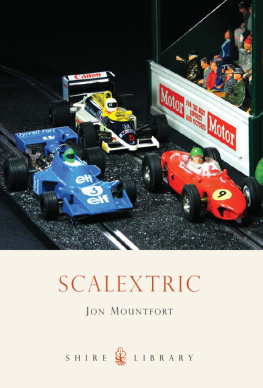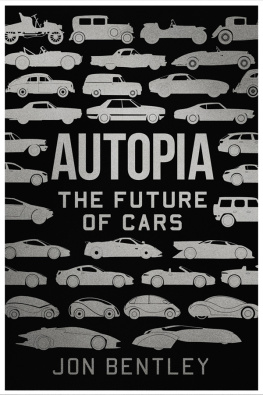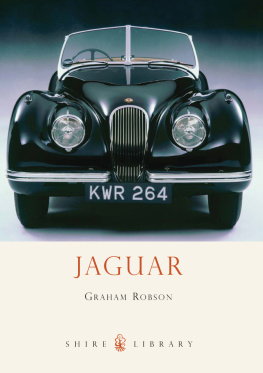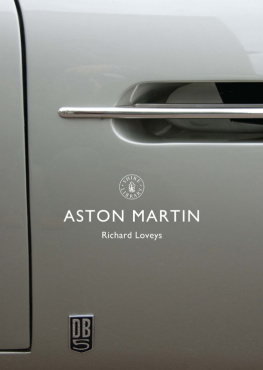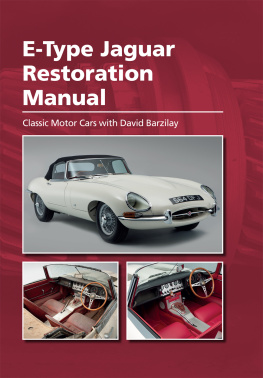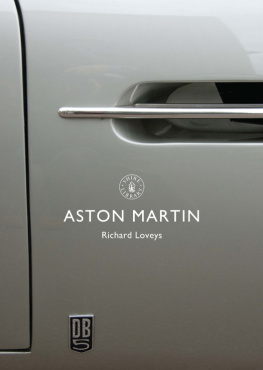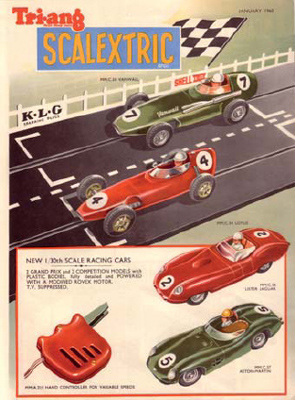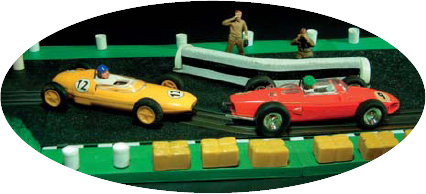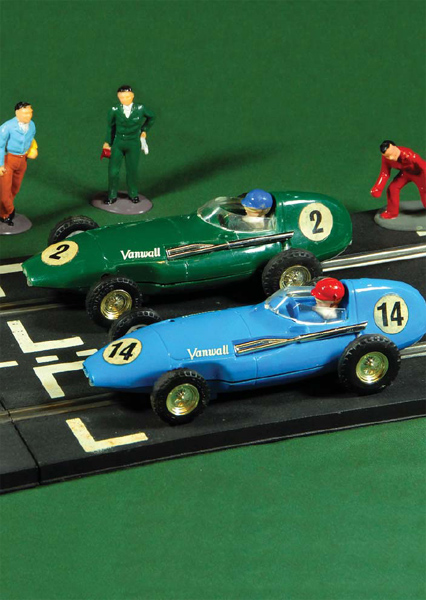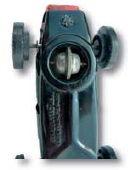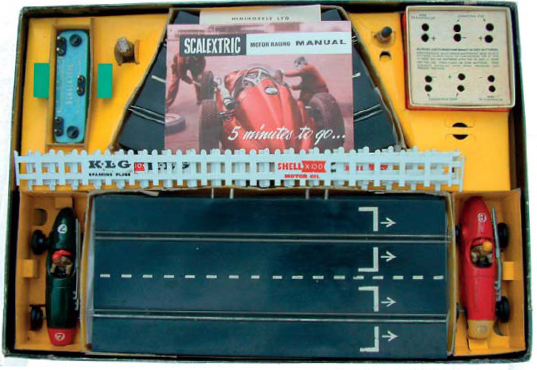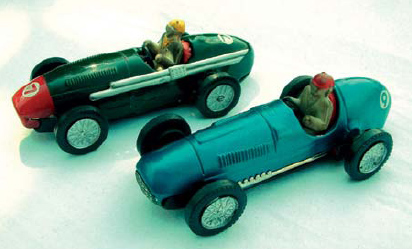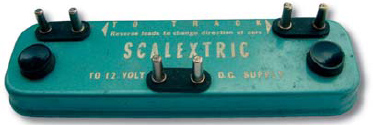SCALEXTRIC
Jon Mountfort
SHIRE PUBLICATIONS
CONTENTS
THE EARLY YEARS
The very first plastic car, the British Vanwall. Notice the rubber track that just pushed together.
JUST LIKE THE REAL THING
T HE DATE is 4 August 1957. The place is the Nrburgring, Germanys most famous motor racing circuit. In pole-position on the grid is Juan Manuel Fangio, already four times World Champion, in his Maserati. Next to him are two English drivers, Mike Hawthorn and Peter Collins in their Ferraris. The chequered flag falls, and Fangio hurtles off for what will be his last ever Formula 1 victory and a fifth world title, the Ferraris roaring after him like greyhounds after the hare.
The date is 25 December 1957. One lucky boy unwraps the paper from a large heavy box-shaped present and sees the magic word Scalextric printed in large letters on the front. Oh wow! You got me that new toy Ive heard about. Feverishly he rips off the remaining wrapping-paper and removes the lid, probably tearing one of its corners in the rush to get at the contents. Pulling off the yellow card cover which holds in all the bits, he grabs one of the cars, a shiny scarlet Maserati. It is made of tinplate, held together with tabs and slots, just as were 50 per cent of all toys manufactured at that time. He fondles its rubber driver, featureless and without legs, then spins the rear wheels as if expecting to hear the engine burst into life. Then he takes out the Ferrari and does the same with that. He has no interest in the little booklet included with the set which comes with the tantalising title 5 minutes to go Dad! he shrieks, Can you help me build it?! Just give me 5 minutes son, comes his fathers reply. Oh well, thinks the lad, Ill have a go at building it myself. Ignoring the instructions, he takes the track from the box and starts putting it together on the pine-needle coated carpet Did you remember to get batteries Dad?... The Scalextric story has begun
WHATS IN A NAME?
Scay-lectric is what most people call it although some try to accommodate the x that they know is present in the name by calling it Scay-lec-trix. Scalex was a range of tinplate toys made by a company called Minimodels in Havant, Hampshire. Their creator, Bertram Francis, known as Fred, a toolmaker turned model engineer, formed Minimodels Ltd in 1947 so that he could sell his own accurate tinplate models of racing cars and sports cars such as the Jaguar XK120. Power for these models was the pull-back clockwork motor. Each vehicle had a fifth wheel, which was wound up by being pulled back along the floor, powering the car forwards when it was released. When Fred Francis had his brainwave to electrify Scalex models, presumably during 1955 or 56, he retained this fifth wheel, electrically insulated it down the middle so that it could pick up positive electric current from one side and negative electric current from the other, then made it tapered and thin enough at the circumference to run in a metal slot mounted in a rubber track. When these cars were fitted with an electric motor driving the back wheels, the fifth wheel, known as a gimbal, both collected current from the track and steered it along the slot, the front wheels of the car merely being decoration and not contributing functionally in any way. Since the forebears of the new cars were called Scalex, and these had an electric motor, he called them Scalextric.
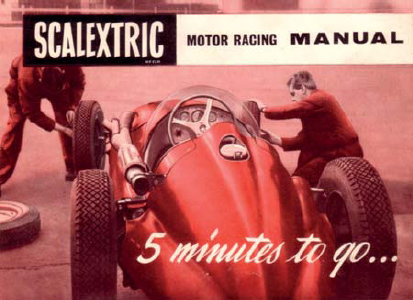
The first Scalextric instruction booklet was called 5 minutes to go and had a great picture of Fangios Maserati on the front.
The fifth wheel or gimbal, insulated between the two halves, provided both current collection and steering. The fluff around the spindle was a common affliction for all Scalextric cars.
THE FIRST SETS
Unsurprisingly, the first sets were called Set 1, Set 2 and Set 3. The first car was the Maserati 250F, which Fangio drove to victory at the Nrburgring: having been 40 seconds behind Hawthorn and Collins with ten laps to go, he proceeded to break the lap record on every subsequent lap, overtaking the two Ferraris just before the chequered flag. Set 1 contained two of these Maseratis and an oval of the extremely smelly rubber track that was used for the first six years of Scalextrics existence until replaced by the now-familiar plastic variety.
Set 1 with its two Maseratis, cardboard battery box (top right), controller (top left) and instruction booklet. The oil bottle is next to the controller and the skid oil is next to the battery box.
At some point during the first year, a Ferrari 4.5L became available, which would have been approximately modelled on a Tipo 801 as driven by Hawthorn and Collins, although not necessarily in the correct scarlet colour! (In fact there are only green and blue tinplate Ferraris the author has never seen a red one other than the earlier Scalex version with the clockwork motor.) The sets were soon sold with one of each type of car.
The first two tinplate cars with their hand-less rubber drivers, the Ferrari in the foreground, the Maserati behind.
For the first three years of its existence, Scalextric was available as just these sets, plus one extra car, the tinplate Austin-Healey. This was made in very small quantities, not included in any of the sets, and is now extremely rare. The main difference between the three sets was the track configuration: Set 1 had an oval track; Set 2 had a figure-of-eight with crossroads; and Set 3 had a figure-of-eight track with flyover bridge. No transformer was supplied with the sets (this didnt occur until the 1970s), but a cardboard battery holder was included. This was printed on the outside to look like a building, and power was supplied by three 4.5-volt zinc/carbon batteries. The controller (for there was only one, shared by both participants) was a tinplate box with two on/off switches, one for each track. Unbelievably, the only available control was all or nothing full blast or stop!
The shared controller just an on/off button for each track.
If you can imagine the shiny rubber back wheels of the cars struggling for grip on the shiny black rubber of the track, you have some idea of how difficult these things were to control. But, incredibly, the Scalextric designers obviously didnt think the setup taxing enough for the skills of their drivers because they provided each set with a bottle of Pure Silicone skid patch fluid to make the track just that extra bit slippery!

